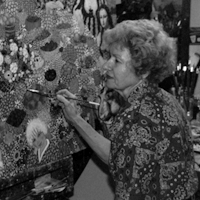Success Starts Here
Your gateway to the Library Catalog, Digital Items, Library Website search results, and more simultaneously!
Your gateway to the Library Catalog, Digital Items, Library Website search results, and more simultaneously!


Jeanne Leighton Lundberg Clarke was born in Alpena, Michigan in 1925. She is a painter whose work is characterized by widely dispersing, crystal-like centers of interest. She lives in Provo, Utah.
Clarke studied at the Chicago Art Institute and at the University of Chicago until she married and settled in Connecticut. While living there, she studied at Yale University. Clarke earned her MFA from Brigham Young University in 1979 and joined the faculty as an instructor of drawing and painting a year later.
Her works, Entertaining Favorite Ladies II (1993), The Earth is Full of Goodness of the Lord: Portrait of Rebecca (1985), and Woman After Catherine, Green #1 (1987), have been selected for the Springville Museum of Art permanent collection.
Biography adapted from Springville Museum of Art
Jeanne Clarke was born in Alpena, Michigan. When she was very young, her family moved to Wyoming, Ohio, a suburb of Cincinnati. Clarke began her artistic training in Chicago, Illinois, where she studied simultaneously at the University of Chicago and at the Chicago Art Institute.
Clarke married at the age of 19 and settled in Connecticut, where she raised three children. While there, she resumed her artistic training, taking private lessons and studying at the Silvermine Guild and at Yale University.
A convert to the Church of Jesus Christ of Latter-day Saints, Clarke wanted to study and better understand her religion. To accomplish this, at the age of 50, she decided to move to Utah and attend Brigham Young University. In five years she earned both her Bachelor of Fine Arts and Master of Fine Arts degrees. After graduating, Clarke began teaching drawing and painting at Brigham Young University.
Jeanne Leighton-Lundberg Clarke is a symbolist; her paintings contain symbols and metaphors that have multiple meanings. Clarke developed her personal style through trial and error, experimenting with Abstraction and Expressionism but finally settling with Realism. Although Jeanne uses Colorfield, Op Art, and Post-Impressionist techniques, she feels her paintings would be meaningless without people. "When you get right down to it, " she says, "people are what it's all about . . . All moments are special. The present moment is all that we have and if we treat each moment, each day, as if it is special, then we are living life to the fullest."
Clarke also considers herself a "maximalist" (an artist who fills every area of the canvas with detailed imagery) because she saturates every inch of the canvas with symbols. She explains, "We are jugglers, trying to be mothers, career women, lovers, housekeepers„the overextended all-around handywoman. We pray that our humor holds up, and that time allows us some pleasure and some freedom to express ourselves. Minimalist art, or non-representational art consisting chiefly of geometric shapes and forms, certainly cannot symbolize a woman's experience."
Intricate and varied, the motifs in Clarke's paintings reflect her philosophy that life is abundant and complex, filled with hidden meanings waiting to be explored. "Everything that is created has a pattern," she notes. "There's a genetic code which seals patterns into us and there are those patterns we have chosen to invite into our lives. Life's events have patterns as well. Our routines are patterns. In my paintings I put patterns over patterns and they become textural. I invite the viewer to sort out the patterns, as in life."
Clarke's style expresses concern about the fundamental importance of women and the family in society. Matriarch of both her own family and her extended family of aspiring student artists, she portrays positive moments of times when family and friends gather together. Her canvases of interior scenes, such as Entertaining Favorite Ladies II, and The Earth is full of the Goodness of the Lord, are usually large and filled with objects of daily existence. Just as in these pieces, most of her paintings have a table in the foreground, abundantly overflowing with decorative containers, floral bouquets, and bowls of fruits and nuts. Symbolically, the table represents the earth and the variety and plentitude of all the good things of life. The containers are visual metaphors for events, surprises, and happenings of human experience.
Biography courtesy of Springville Museum of Art.
Newspaper Articles
"Showing at Local Galleries." The Deseret News, April 25, 2004.
"Showing at Local Galleries." The Deseret News, September 21, 2003.
"Showing at Local Galleries." The Deseret News, July 16, 2000.
"Showing at Local Galleries." The Deseret News, May 12, 2000.
"Showing at Local Galleries." The Deseret News, September 19, 1999.
"Showing at Local Galleries." The Deseret News, July 2, 1989.
Books
Dunbier, Lonnie P. ed. The Artists Bluebook. Scottsdale, AZ: AskART.com, 2003.
Olpin, Robert S., William C. Seifrit, and Vern G. Swanson. Artists of Utah. Salt Lake City, UT: Gibbs Smith Publisher, 1999.
Swanson, Vern G., Robert S. Olpin, and William C. Seifrit. Utah Paintings and Sculpture. Salt Lake City, UT: Gibbs Smith Publishers, 1991.